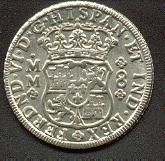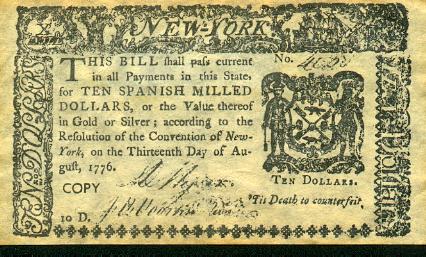|
Two Bits, Four Bits,
Six Bits,a Dollar
by Joseph Perez
Early in the establishment of the thirteen American colonies, there were problems with a short supply of money. Being British subjects, the colonists used the British pound and shilling, but there wasnt much of it circulated in the colonies. In 1652, the Massachusetts Bay Colony opened the first colonial mint and produced what became known as the Oak and Pine tree shillings as well as the threepence and sixpence coins. Thirty six years later, the king ordered the colonists to stop producing the coins. Ever so resourceful, the colonists kept minting the coins, but with the 1652 date on them.
With freedom on their colonial minds, the Continental Congress issued the first American paper money. This Continental Currency was supposedly backed by an equal supply of gold, however, there actually wasnt enough gold to back up all the paper money being printed and it lost its value. Furthermore, the Continentals couldnt be redeemed unless the colonies won their independence from Mother England. As George Washington said, A wagon load of money will scarcely purchase a wagon load of provisions.
At that time, the most widely circulated coin in the world was the Spanish dollar commonly known as a piece of eight (see illustration). It was called a piece of eight because it was equivalent in value to eight smaller denominated coins called reales. Two bits was 25-cents, four bits was a half dollar, six bits was 75-cents and eight bits was a dollar. It is also known as a Spanish milled dollar. Since many of the coins were made from silver, people used to shave off the edges of coins and collect the extra silver shavings. After getting enough shavings, they would sell the silver. The net result was they got more than the face value of the coin in which they shaved. To prevent this, the Spanish piece of eight was milled on the edges, giving it noticeable ridges. Therefore, it would be obvious to notice if a piece of eight was shaven, thus making it worth less than the full dollar.
When the colonists won their independence, they didnt want to use British money, so they opted to use the most common coin in the world, the Spanish milled dollar or piece of eight. Therefore, when George Washington, or Thomas Jefferson, or Benjamin Franklin purchased goods shortly after the American Revolution, they paid with the Spanish piece of eight. Much of the initial paper money of the United States of America was backed by the Spanish coins. One example is a ten dollar bill from the state of New York (see illustration) with the words This bill shall pay current in all payments in this state for ten Spanish milled dollars, or the value thereof in gold or silver; according to the resolution of the Convention of New York, on the thirteenth day of August, 1776.
So you have it that Spain not only provided valuable aid to the colonists during the American Revolution, they also provided the first currency of the new nation that was respected throughout the world. Now thats something to cheer about. Here it goesTwo bits, four bits, six bits, a dollar, all for Gálvez stand up an holler!


|

